2009 CHEVROLET IMPALA child seat
[x] Cancel search: child seatPage 71 of 406
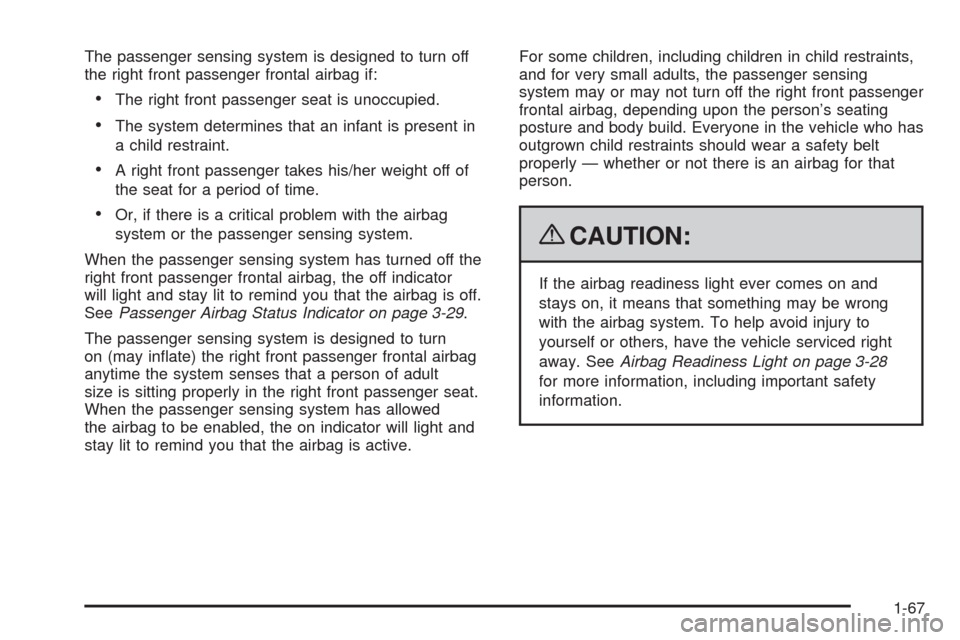
The passenger sensing system is designed to turn off
the right front passenger frontal airbag if:
The right front passenger seat is unoccupied.
The system determines that an infant is present in
a child restraint.
A right front passenger takes his/her weight off of
the seat for a period of time.
Or, if there is a critical problem with the airbag
system or the passenger sensing system.
When the passenger sensing system has turned off the
right front passenger frontal airbag, the off indicator
will light and stay lit to remind you that the airbag is off.
SeePassenger Airbag Status Indicator on page 3-29.
The passenger sensing system is designed to turn
on (may in�ate) the right front passenger frontal airbag
anytime the system senses that a person of adult
size is sitting properly in the right front passenger seat.
When the passenger sensing system has allowed
the airbag to be enabled, the on indicator will light and
stay lit to remind you that the airbag is active.For some children, including children in child restraints,
and for very small adults, the passenger sensing
system may or may not turn off the right front passenger
frontal airbag, depending upon the person’s seating
posture and body build. Everyone in the vehicle who has
outgrown child restraints should wear a safety belt
properly — whether or not there is an airbag for that
person.
{CAUTION:
If the airbag readiness light ever comes on and
stays on, it means that something may be wrong
with the airbag system. To help avoid injury to
yourself or others, have the vehicle serviced right
away. SeeAirbag Readiness Light on page 3-28
for more information, including important safety
information.
1-67
Page 72 of 406
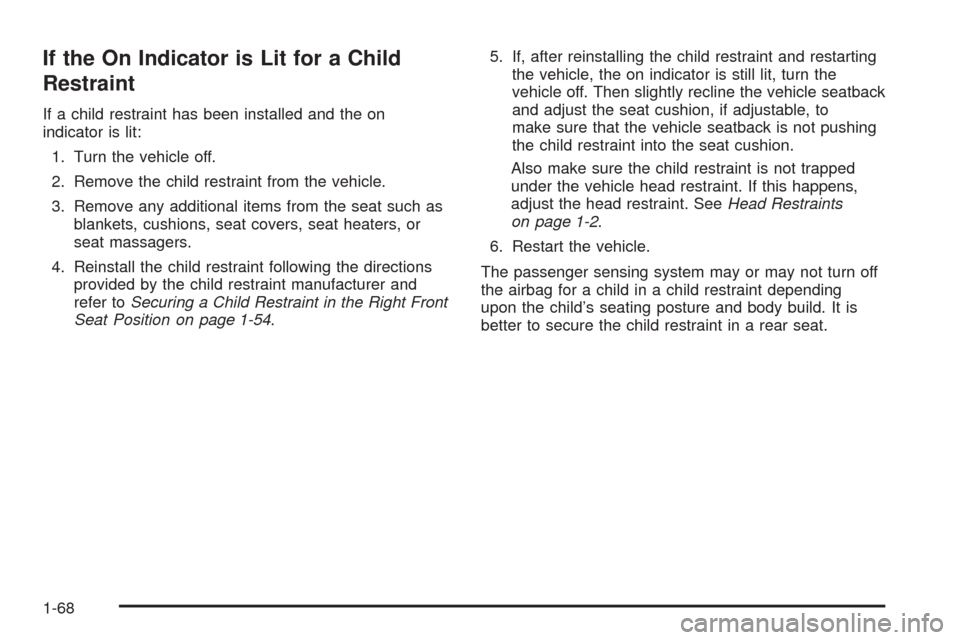
If the On Indicator is Lit for a Child
Restraint
If a child restraint has been installed and the on
indicator is lit:
1. Turn the vehicle off.
2. Remove the child restraint from the vehicle.
3. Remove any additional items from the seat such as
blankets, cushions, seat covers, seat heaters, or
seat massagers.
4. Reinstall the child restraint following the directions
provided by the child restraint manufacturer and
refer toSecuring a Child Restraint in the Right Front
Seat Position on page 1-54.5. If, after reinstalling the child restraint and restarting
the vehicle, the on indicator is still lit, turn the
vehicle off. Then slightly recline the vehicle seatback
and adjust the seat cushion, if adjustable, to
make sure that the vehicle seatback is not pushing
the child restraint into the seat cushion.
Also make sure the child restraint is not trapped
under the vehicle head restraint. If this happens,
adjust the head restraint. SeeHead Restraints
on page 1-2.
6. Restart the vehicle.
The passenger sensing system may or may not turn off
the airbag for a child in a child restraint depending
upon the child’s seating posture and body build. It is
better to secure the child restraint in a rear seat.
1-68
Page 74 of 406
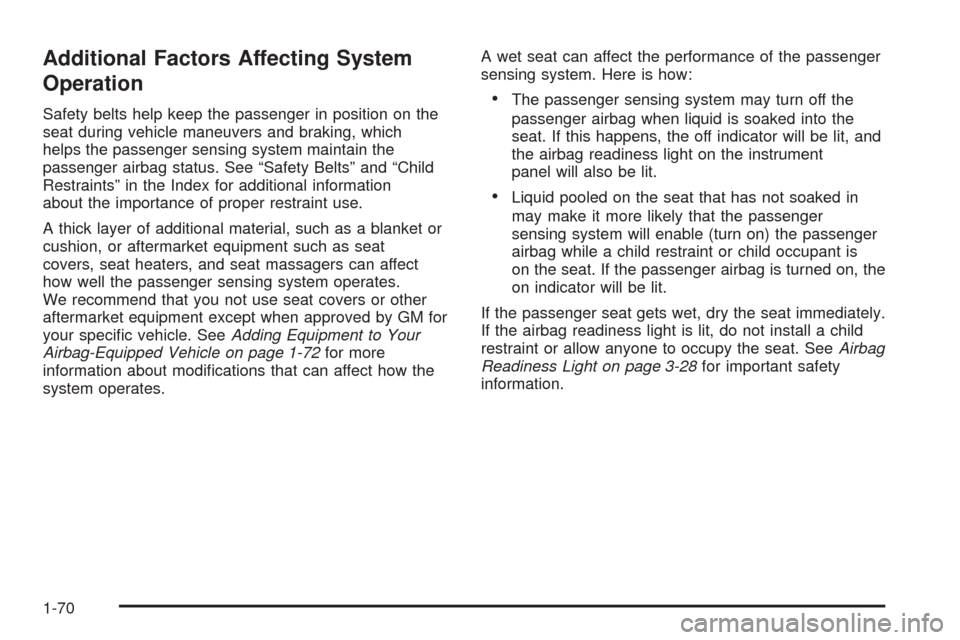
Additional Factors Affecting System
Operation
Safety belts help keep the passenger in position on the
seat during vehicle maneuvers and braking, which
helps the passenger sensing system maintain the
passenger airbag status. See “Safety Belts” and “Child
Restraints” in the Index for additional information
about the importance of proper restraint use.
A thick layer of additional material, such as a blanket or
cushion, or aftermarket equipment such as seat
covers, seat heaters, and seat massagers can affect
how well the passenger sensing system operates.
We recommend that you not use seat covers or other
aftermarket equipment except when approved by GM for
your speci�c vehicle. SeeAdding Equipment to Your
Airbag-Equipped Vehicle on page 1-72for more
information about modi�cations that can affect how the
system operates.A wet seat can affect the performance of the passenger
sensing system. Here is how:The passenger sensing system may turn off the
passenger airbag when liquid is soaked into the
seat. If this happens, the off indicator will be lit, and
the airbag readiness light on the instrument
panel will also be lit.
Liquid pooled on the seat that has not soaked in
may make it more likely that the passenger
sensing system will enable (turn on) the passenger
airbag while a child restraint or child occupant is
on the seat. If the passenger airbag is turned on, the
on indicator will be lit.
If the passenger seat gets wet, dry the seat immediately.
If the airbag readiness light is lit, do not install a child
restraint or allow anyone to occupy the seat. SeeAirbag
Readiness Light on page 3-28for important safety
information.
1-70
Page 93 of 406
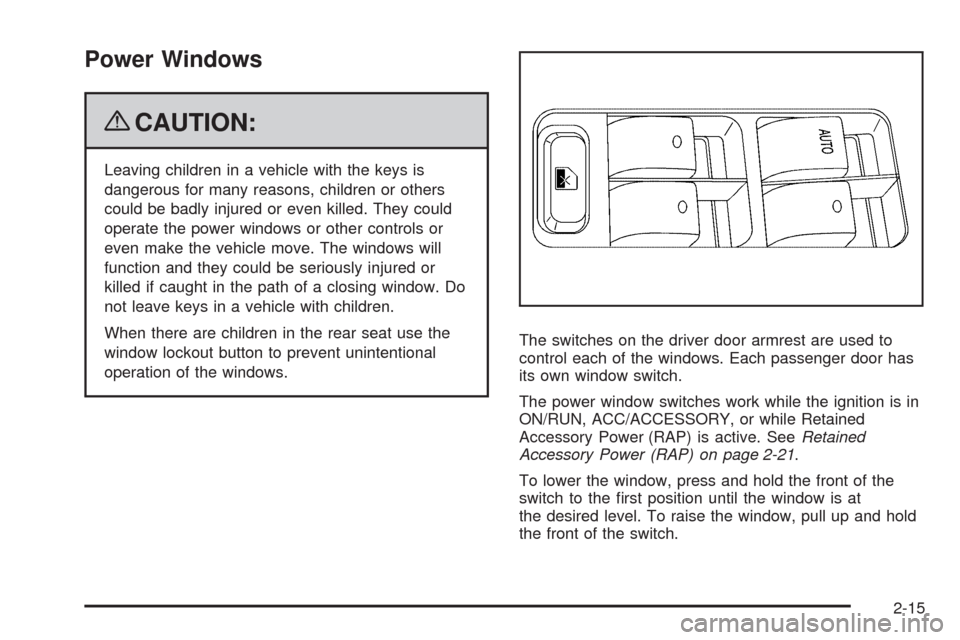
Power Windows
{CAUTION:
Leaving children in a vehicle with the keys is
dangerous for many reasons, children or others
could be badly injured or even killed. They could
operate the power windows or other controls or
even make the vehicle move. The windows will
function and they could be seriously injured or
killed if caught in the path of a closing window. Do
not leave keys in a vehicle with children.
When there are children in the rear seat use the
window lockout button to prevent unintentional
operation of the windows.The switches on the driver door armrest are used to
control each of the windows. Each passenger door has
its own window switch.
The power window switches work while the ignition is in
ON/RUN, ACC/ACCESSORY, or while Retained
Accessory Power (RAP) is active. SeeRetained
Accessory Power (RAP) on page 2-21.
To lower the window, press and hold the front of the
switch to the �rst position until the window is at
the desired level. To raise the window, pull up and hold
the front of the switch.
2-15
Page 243 of 406

Never exceed the GVWR for your vehicle or the
Gross Axle Weight Rating (GAWR) for either
the front or rear axle.
If the vehicle is going to carry a heavy load,
spread it out. See “Steps for Determining Correct
Load Limit” earlier in this section.
{CAUTION:
Do not load the vehicle any heavier than the
Gross Vehicle Weight Rating (GVWR), or
either the maximum front or rear Gross Axle
Weight Rating (GAWR). If you do, parts on the
vehicle can break, and it can change the way
your vehicle handles. These could cause you
to lose control and crash. Also, overloading
can shorten the life of the vehicle.
Notice
:Overloading your vehicle may cause
damage. Repairs would not be covered by your
warranty. Do not overload your vehicle.
If things like suitcases, tools, packages, or
anything else are put inside the vehicle, they will
go as fast as the vehicle goes. If you have to stop
or turn quickly, or if there is a crash, they will
keep going.
{CAUTION:
Things you put inside the vehicle can strike
and injure people in a sudden stop or turn, or
in a crash.
Put things in the trunk of your vehicle. In
a trunk, put them as far forward as you
can. Try to spread the weight evenly.
Never stack heavier things, like
suitcases, inside the vehicle so that some
of them are above the tops of the seats.
Do not leave an unsecured child restraint
in the vehicle.
When you carry something inside the
vehicle, secure it whenever you can.
Do not leave a seat folded down unless
you need to.
4-25
Page 395 of 406
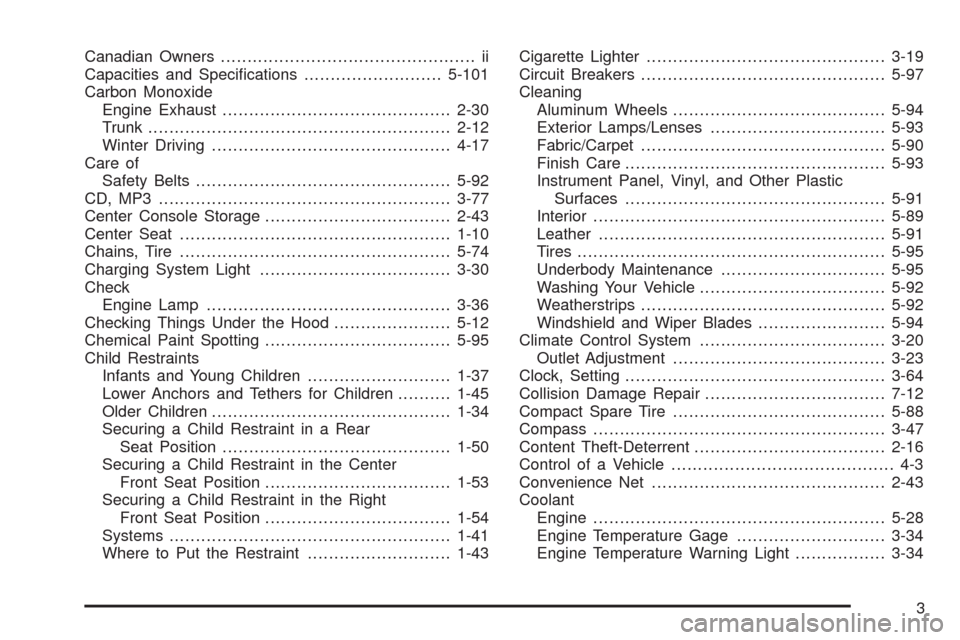
Canadian Owners................................................ ii
Capacities and Speci�cations..........................5-101
Carbon Monoxide
Engine Exhaust...........................................2-30
Trunk.........................................................2-12
Winter Driving.............................................4-17
Care of
Safety Belts................................................5-92
CD, MP3 .......................................................3-77
Center Console Storage...................................2-43
Center Seat...................................................1-10
Chains, Tire...................................................5-74
Charging System Light....................................3-30
Check
Engine Lamp..............................................3-36
Checking Things Under the Hood......................5-12
Chemical Paint Spotting...................................5-95
Child Restraints
Infants and Young Children...........................1-37
Lower Anchors and Tethers for Children..........1-45
Older Children.............................................1-34
Securing a Child Restraint in a Rear
Seat Position...........................................1-50
Securing a Child Restraint in the Center
Front Seat Position...................................1-53
Securing a Child Restraint in the Right
Front Seat Position...................................1-54
Systems.....................................................1-41
Where to Put the Restraint...........................1-43Cigarette Lighter.............................................3-19
Circuit Breakers..............................................5-97
Cleaning
Aluminum Wheels........................................5-94
Exterior Lamps/Lenses.................................5-93
Fabric/Carpet..............................................5-90
Finish Care.................................................5-93
Instrument Panel, Vinyl, and Other Plastic
Surfaces.................................................5-91
Interior.......................................................5-89
Leather......................................................5-91
Tires
..........................................................5-95
Underbody Maintenance...............................5-95
Washing Your Vehicle...................................5-92
Weatherstrips..............................................5-92
Windshield and Wiper Blades........................5-94
Climate Control System...................................3-20
Outlet Adjustment........................................3-23
Clock, Setting.................................................3-64
Collision Damage Repair..................................7-12
Compact Spare Tire........................................5-88
Compass.......................................................3-47
Content Theft-Deterrent....................................2-16
Control of a Vehicle.......................................... 4-3
Convenience Net............................................2-43
Coolant
Engine.......................................................5-28
Engine Temperature Gage............................3-34
Engine Temperature Warning Light.................3-34
3
Page 400 of 406

Lights (cont.)
Fog Lamp ..................................................3-40
Highbeam On.............................................3-40
High/Low Beam Changer................................ 3-8
Oil Pressure...............................................3-39
Passenger Airbag Status Indicator..................3-29
Safety Belt Reminders..................................3-27
Security.....................................................3-39
Tire Pressure..............................................3-35
Traction Control System (TCS) Warning..........3-32
Loading Your Vehicle.......................................4-20
Locks
Automatic Door Lock....................................2-10
Delayed Locking..........................................2-10
Door ........................................................... 2-9
Lockout Protection.......................................2-12
Power Door ................................................2-10
Programmable Automatic Door Unlock............2-11
Rear Door Security Locks.............................2-11
Loss of Control...............................................4-11
Lower Anchors and Tethers for Children.............1-45
Lumbar
Manual Controls............................................ 1-6M
Maintenance
Footnotes..................................................... 6-7
Maintenance Schedule
Additional Required Services........................... 6-6
At Each Fuel Fill........................................... 6-8
At Least Once a Month.................................. 6-9
At Least Once a Year.................................... 6-9
Maintenance Record....................................6-15
Maintenance Replacement Parts....................6-13
Maintenance Requirements............................. 6-2
Owner Checks and Services........................... 6-8
Recommended Fluids and Lubricants.............6-12
Scheduled Maintenance................................. 6-4
Using.......................................................... 6-3
Your Vehicle and the Environment................... 6-2
Malfunction Indicator Lamp...............................3-36
Manual Lumbar Controls.................................... 1-6
Manual Seats................................................... 1-4
Message
DIC Warnings and Messages........................3-49
Mirror Reading Lamps.....................................3-17
8
Page 403 of 406
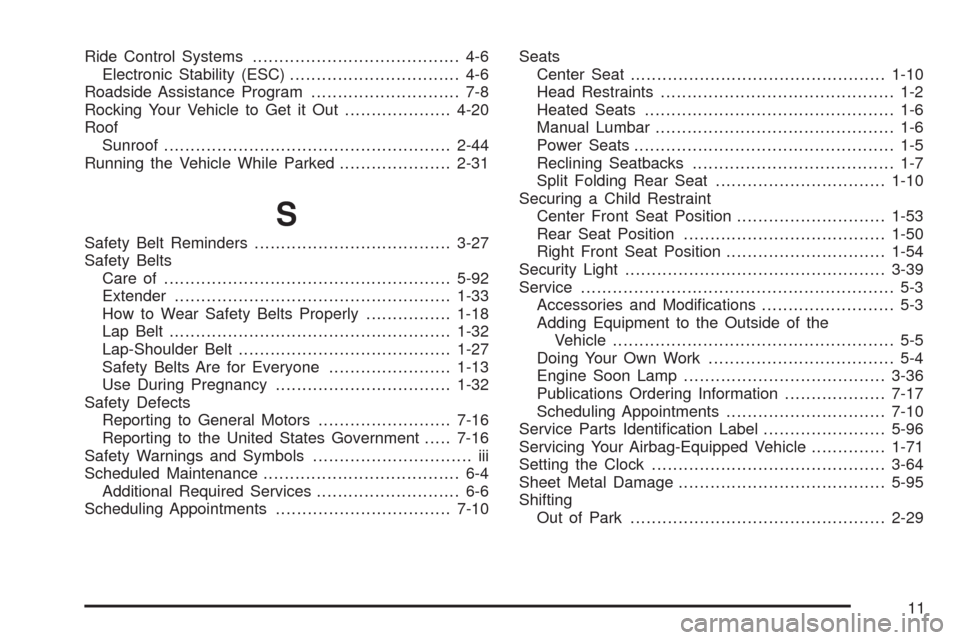
Ride Control Systems....................................... 4-6
Electronic Stability (ESC)................................ 4-6
Roadside Assistance Program............................ 7-8
Rocking Your Vehicle to Get it Out....................4-20
Roof
Sunroof......................................................2-44
Running the Vehicle While Parked.....................2-31
S
Safety Belt Reminders.....................................3-27
Safety Belts
Care of ......................................................5-92
Extender....................................................1-33
How to Wear Safety Belts Properly................1-18
Lap Belt.....................................................1-32
Lap-Shoulder Belt........................................1-27
Safety Belts Are for Everyone.......................1-13
Use During Pregnancy.................................1-32
Safety Defects
Reporting to General Motors.........................7-16
Reporting to the United States Government.....7-16
Safety Warnings and Symbols.............................. iii
Scheduled Maintenance..................................... 6-4
Additional Required Services........................... 6-6
Scheduling Appointments.................................7-10Seats
Center Seat................................................1-10
Head Restraints............................................ 1-2
Heated Seats............................................... 1-6
Manual Lumbar............................................. 1-6
Power Seats................................................. 1-5
Reclining Seatbacks...................................... 1-7
Split Folding Rear Seat................................1-10
Securing a Child Restraint
Center Front Seat Position............................1-53
Rear Seat Position......................................1-50
Right Front Seat Position..............................1-54
Security Light.................................................3-39
Service........................................................... 5-3
Accessories and Modi�cations......................... 5-3
Adding Equipment to the Outside of the
Vehicle..................................................... 5-5
Doing Your Own Work................................... 5-4
Engine Soon Lamp......................................3-36
Publications Ordering Information...................7-17
Scheduling Appointments..............................7-10
Service Parts Identi�cation Label.......................5-96
Servicing Your Airbag-Equipped Vehicle..............1-71
Setting the Clock............................................3-64
Sheet Metal Damage.......................................5-95
Shifting
Out of Park................................................2-29
11